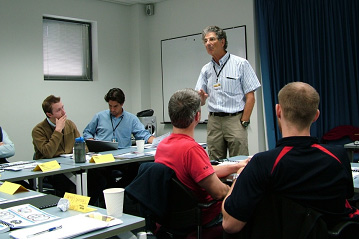
Introduction to Education in Cryogenics
|
EDUCATION IN CRYOGENICS Introduction Why ? This educational program has been set up to make attendants understand cryogenics and more specifically, helium refrigeration. It is not intended to teach how to design refrigeration plants or cryogenic systems, even if the information that is delivered is of prior importance for that purpose. How ? The main guideline of the courses is the natural thinking path that one follows when studying a problem. Difficulty and complexity go increasing with progression in the topic. Theory is limited to what is strictly necessary to understand the processes that are introduced and discussed in the course. It is not intended to teach Thermodynamics. Only a few equations are displayed. The goal is to make people "feel" the operation of machines; for example, in the helium refrigeration basic cycle presentations, emphasis is put on energy circulation in the systems. The entire course is given through "animated" Microsoft PowerPoint® and Excel® presentations. Here, the goal is to make people follow explanations in a comfortable way: the presentation displays information at the same rate as oral explanations, as if the orator were drawing on a black board (see Advances in Cryogenic Engineering, Vol. 49A, CEC 2003, Anchorage, pages: 101 to 110). Click here to see an example of presentation. The Excel® animated presentations allow making "live" calculations on situations that are significant; for example, the way in which the exchange diagram of a heat exchanger is modified according to the operating conditions. Prior to the course, a document, which is printed by the organiser, is delivered to the participants. On such document, which is a print out of the slides, the participant can make personal notes, at the right place. Every time it is possible, samples or small components that can be easily transported by the speaker are presented. If a plant if is in the vicinity, it is of a high interest to visit it in order to identify all components that have been described during the course. The course language is generally English. It can also be French or Spanish, but the slides and document are always in English. It is of interest that attendants bring with them his (her) own PC loaded with the “REFPROP®” (and, possibly, “Hepak®”) software. Simple but very useful thermodynamical calculation exercises can be run collectively, each participant performing on his own PC. Whom for ?
How long ? Each educational session is composed of various modules and lasts two to four days (see programmes, here under). Where ? It is of interest that the school is held in a place where attendants can visit a cryogenic system: that allows “seeing and touching” the components that were introduced during the course. How many participants? There is no limit in participant number for modules that are presented. However, for sessions where calculation take place, the number of participants must be reasonably limited to 10. Experience in such educational programme “Basics In Cryogenics”, “Helium Refrigeration” and other customised courses have been delivered at various places in the world: Australia, France, India, Italy, Netherlands, Poland, P. R. of China, South Korea, Spain, Switzerland, USA, for a total of 80 sessions and 1150 attendants, as of April 2024. Property The material for the school (presentations) belongs to Guy Gistau Baguer and remains his. He can use it at any time and at any place. Reproduction of this material is not allowed, however, a special agreement could be made between the Author and the local organisation. |